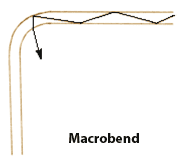Glossary
Macrobending
Macrobending occurs when the Fiber is bent into a visible curvature. Macrobends are caused by incorrect installation and are commonly found AT fiber organizers and patch cables. Environmental changes can also cause macrobending. Macrobending results in attenuation. Macrobending is reversible.
A relatively large-radius bend in an Optical Fiber may be found in a Splice organizer Tray or a fiber-optic Cable that has been bent.
Note: A macrobend will result in no significant Radiation Loss IF it is of sufficiently large radius. The definition of “sufficiently large” depends on the type of fiber. Single-mode fibers have a low numerical aperture, typically less than 0.15, and are therefore are more susceptible to bend losses than other types. Normally, they will not tolerate a minimum Bend Radius of less than 6.5 to 7.5 cm (2.5 to 3 inches). Certain specialized types of single-mode fibers, however, can tolerate a FAR shorter Minimum Bend Radius without appreciable loss. A Graded-Index Multimode fiber having a Core diameter of 50 M and a Numerical Aperture of 0.20 will typically tolerate a minimum bend radius of not less than 3.8 cm (1.5 inches). The fibers commonly used in customer-premises applications (62.5-m core) typically have a relatively high numerical aperture, (approximately 0.27), and can tolerate a bend radius of less than an inch (2.5 cm).
See Microbending
See Bending Loss

